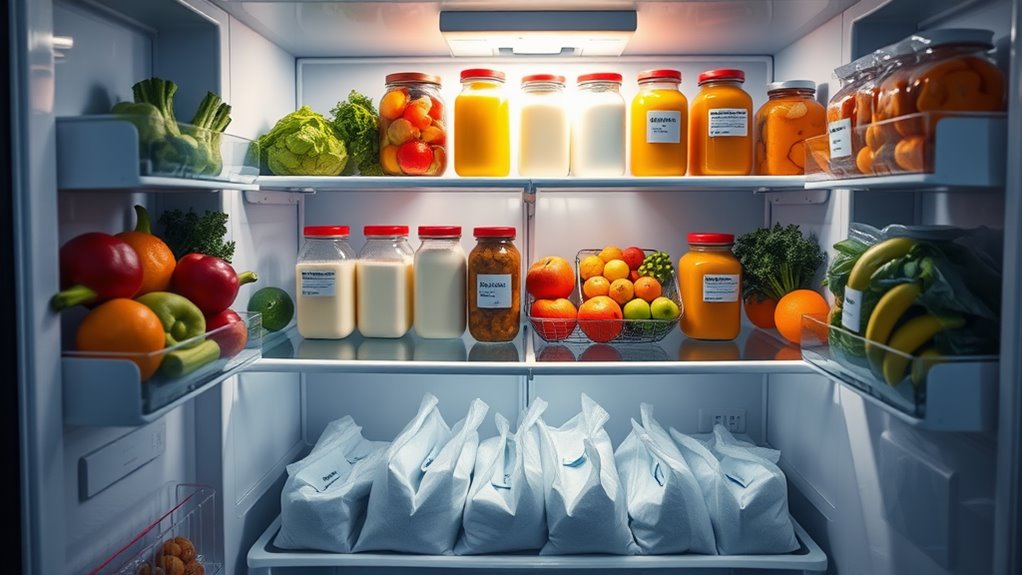Fridge Organization Tips That Will Change Your Life
Did you know that the average person wastes over 200 pounds of food yearly due to poor fridge organization? You can avoid this by transforming your fridge into a streamlined space with simple, effective tips. Start with smart storage and categorization to save time and reduce stress. Curious about how to make your kitchen routine effortless? Stick around to uncover practical strategies that’ll revolutionize your daily life.
Key Takeaways
- Use stackable clear containers to maximize space and easily see contents without rummaging.
- Categorize food items by grouping similar products together for quick, efficient access.
- Label shelves for specific categories like dairy or leftovers to maintain order effortlessly.
- Rotate stock by placing newer items at the back to minimize food waste.
- Utilize crisper drawers with humidity settings to keep fruits and veggies fresh longer.
Maximizing Space With Smart Storage Solutions
How can you make the most of your fridge space?
Start by evaluating every inch with smart fridge organization ideas. Use stackable containers to layer items vertically, freeing up shelf room. Install adjustable bins on doors for quick-grab essentials like condiments. Opt for clear storage boxes to see contents at a glance, preventing forgotten items. Place taller bottles in the back and shorter ones upfront for easy reach. Don’t overcrowd—leave gaps for air circulation.
Finally, utilize under-shelf baskets to hang lightweight goods, doubling your storage. With these steps, you’ll transform clutter into order efficiently. For a budget-friendly approach, explore dollar store items to find affordable organizers that maximize space.
Categorizing Food Items for Easy Access
Start organizing your fridge by grouping similar food items together for quick access.
Place dairy products like milk, cheese, and yogurt on one shelf for easy retrieval.
Keep fruits and vegetables in designated drawers to maintain freshness and visibility.
Store meats in a separate section, ideally on the bottom shelf, to prevent drips contaminating other foods.
Group condiments and sauces in a door compartment for convenience.
By categorizing items systematically, you’ll save time and reduce waste.
Check your setup weekly to ensure everything’s in its place, and adjust as needed for efficiency.
Consider using clear containers for leftovers to maximize space and easily see what’s inside.
Using Clear Containers to Stay Organized
While organizing your fridge, invest in clear containers to keep everything visible and accessible.
These containers let you see contents at a glance, so you’re not rummaging through clutter.
Choose stackable options to maximize space and maintain a tidy look.
Store leftovers, prepped veggies, or snacks in them, grouping similar items together for efficiency.
Place containers on shelves where you can easily reach them, ensuring frequently used items are upfront.
Clean them regularly to avoid buildup.
With clear containers, you’ll save time, reduce waste, and keep your fridge orderly, making meal prep a breeze every day.
This simple hack can transform even the most chaotic refrigerator into a neat space in just minutes.
Labeling Shelves for Quick Identification
A simple yet effective way to streamline your fridge organization is by labeling shelves for quick identification. Grab a label maker or some masking tape and a marker. Assign specific shelves for categories like dairy, drinks, or leftovers. Clearly mark each shelf with its designated purpose.
This way, you’ll instantly know where to look or store items, saving time and reducing clutter.
Stick to your system by consistently placing items on their labeled shelves. If everyone in your household follows this, you’ll maintain order effortlessly. Update labels as needed to adapt to changing storage needs. Additionally, this quick hack can be done in just five minutes or less, transforming your fridge into an organized space.
Keeping Fresh Produce in Optimal Conditions
When storing fresh produce, make sure you handle leafy greens with care by wrapping them in a damp paper towel and placing them in a sealed bag to maintain moisture.
Don’t forget to use your fridge’s crisper drawers wisely, adjusting humidity settings to suit specific fruits and veggies for longer freshness.
These simple steps’ll help you keep your produce in top condition and reduce waste.
Store Leafy Greens Properly
Start storing your leafy greens with care to keep them crisp and fresh for longer.
Don’t let spinach or kale wilt before you use them.
With a few practical steps, you’ll extend their life and maintain flavor.
Follow these tips for optimal storage:
- Wash and Dry: Rinse greens thoroughly, then pat them dry to avoid moisture buildup.
- Wrap in Towels: Use a clean kitchen towel to wrap them, absorbing excess water.
- Use Airtight Containers: Store wrapped greens in sealed containers to protect them.
- Check Regularly: Discard any spoiled leaves promptly.
Use Crisper Drawers Wisely
Beyond storing leafy greens, make sure you’re utilizing your fridge’s crisper drawers to keep all fresh produce in top condition. Adjust the humidity settings—use high humidity for vegetables like carrots and cucumbers to prevent wilting, and low humidity for fruits like apples to avoid excess moisture.
Store similar items together to maintain consistent conditions.
Don’t overcrowd; leave space for air circulation.
Check regularly for spoiled items and remove them promptly to prevent ethylene gas from affecting others.
Line drawers with paper towels to absorb moisture, extending freshness.
With these steps, you’ll maximize produce life efficiently.
Rotating Stock to Minimize Food Waste
Take a strategic approach to fridge organization by rotating your stock to minimize food waste. You’ve gotta keep track of what’s fresh and what’s nearing expiration. Place newer items at the back and older ones at the front so you’ll use them first. This simple habit prevents forgotten food from spoiling.
Follow these steps for effective rotation:
- Check dates weekly – Scan expiration dates to prioritize usage.
- Organize by category – Group similar items together.
- Label leftovers – Mark dates on containers.
- Review before shopping – Avoid buying duplicates of existing stock.

